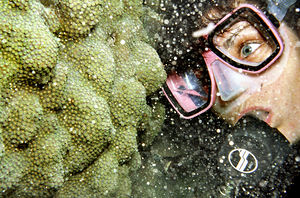TypesofRestoration
Types of Restoration
Restoration methods attempt to help a degraded and destroyed ecosystem recover their ecological structure and function. There are two types of restoration methods for coral reefs: physical and biological. When implementing restoration methods for coral reefs various types and methods must be used together to succeed.
Physical Restoration
Physical restoration is all about the physical structure of the coral reefs. It is repairing the ecosystem under the lens of an engineer. Physical restoration is used when coral reefs undergo physical stress from activities like bottom trawling, dynamite fishing, and sinking of ships. When coral reefs undergo physical stress, quick and efficient "triage and repair" methods help alleviate potential after-effect damage and encourage a faster recovery time for coral reefs. For example, physical stress often creates an unstable base that overturns and smothers any corals that grow on them. They are the “killing field of coral reefs”. To stabilize the base a stable substrate like flexible rubber cement mats or limestone boulders are placed on top of rubbles to create a stable base for corals to grow on. Another example is the removal of foreign debris that can act as propellants, destroying and wreaking havoc on coral reefs during storms.
Artificial reefs are also created to help maintain needed topographic complexity for a thriving ecosystem. They attempt to mimic the structure and function of reefs. Reef balls and 3-D printed reefs made of marine friendly materials are becoming popular. They provide habitats for corals and other invertebrates, provide shoreline protection, and help alleviate human stress like bottom trawling or tourists.
Major physical restoration can get very expensive, costing up from $100,000 to $1,000,000 per hectare. However, physical restoration can be effective if they are well planned and done efficiently.
Mona Island, Puerto Rico
After the sinking of the Fortuna Reefer ship in Mona Island, Puerto Rico, defragmented corals were attached to stable substrates with wires, saving 57% of the fragments.
Fort Lauderdale, Florida
However, in Fort Lauderdale, Florida an attempt to create an artificial reef out of tires wired together backfired as the wires came loose under the pressure of storms. These tires rampaged around the reefs destroying corals and the reef.
Biological Restoration
Biological restoration is a very important step that should come after physical restoration. Physical restoration can only be passed over if proper substrates are already in place for a certain reef area. If physical restoration is skipped over when it should not be, biological restoration alone will not work. However, if physical restoration has occurred or is proven to be unneeded, biological restoration rebuilds and maintains ecosystem services like biodiversity and habitat (“Restoring Reefs: Demonstrating Hope”). Biodiversity is critical to a reef’s success because it increases resilience and survival. Variety is needed in gene pools, especially in the wake of climate change, in order for species to better adapt and evolve to changing living conditions. Also, the biodiversity of corals directly impacts the biodiversity of fish and other creatures, because the coral structures provide habitats for many different species.
There are many ways to approach biological restoration, but each fall into one of two categories: active and passive. Active restoration is a more direct approach, with humans physical human projects to help the reefs. These projects typically take place in nurseries and include rehabilitation of broken corals, propagation to grow smaller or broken corals, and culturing coral larvae, which are all followed by transplanting the corals back into the natural reef environment. As for the biological restoration of reef creatures, such as fish, clams, and symbionts, they are oftentimes directly integrated into the ecosystem after the corals have been restored (“Introduction to Coral Restoration”). Passive approaches have more to do with government policy and law, managing coral reefs indirectly in hopes of natural recovery. Policy changes can include pollution control or fishing restrictions (Clark, 13).
Philippines
The Bolinao Coral Reef Targeted Research Program in the Philippines aimed to restore the reef and biodiversity. By using a nursery and the techniques of rehabilitation and propagation above, they were able to transplant 200 corals into the natural habitat. After just 6 months, 50% of those corals self-attached to the substrate. They were able to accomplish this goal not only by providing the proper research, techniques, and divers needed, but also by community engagement. They offered dive classes to nearby citizens and taught them about the conservation efforts taking place. It was very important to keep the project going with lots of support (Mickelfield, 10).

References
- ↑ "Late Summer Full Moons to Cue Spawning on Keys Coral Reefs | NewmanPR." NewmanPR. N.p., n.d. Web. 17 Apr. 2013.